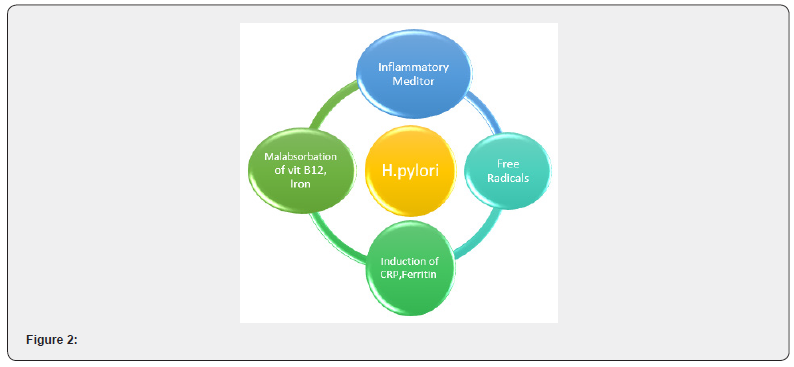Juniper Publishers- Open Access Journal of Case Studies
Medical Interaction between Helicobacter Pylori and Chest Pain - a Case Study
Authored by Walaa Fikry Elbossaty
Abstract
Helicobacter pylori microbe is considered one of the fiercest types of bacteria that infects the digestive system and is due to its ferocity in that it not only affects the digestive system, but causes stomach ulcers and esophageal reflux, and that affects the task of the digestive system in terms of being the organ that causes the absorption of various foodstuffs that a person needs in his life Daily and one of the most important substances that affect iron absorption, resulting in iron deficiency anemia and affecting the absorption of vitamin B12, not only this, but microbial infection affects the chest, causing pain and the patient feels short of breath and uneasy. Therefore, an appropriate and rapid diagnosis of this microbe is necessary before it penetrates and spreads and adversely affects many members.
Keywords:Helicobacter pylori; Iron deficiency anemia; Inflammation; Chest pain
Background
Helicobacter pylori (H.pylori) are a unipolar and microaerophilic bacterium. It contains five major outer membrane protein families [1]. It is one of the most important pathogenic bacteria that infect the digestive system, and it has been found that there is a close relationship between the H.pylori infection and esophageal reflux and chest pain, in addition to the incidence of stomach ulcers [2]. It is a type of gram negative bacteria, the outer membrane consists of fats and sugar fats in addition to cholesterol particles, and the fluidity and movement of bacteria is due to the presence of 2 to 6 flagella and the bacteria have the ability to secrete many enzymes like oxidase, catalase and re-enzymes [3]. These bacteria can adapt in their lives with the acidic environment of the stomach, through the secretion of the enzyme urease, which has the ability to convert urea that is excreted in the stomach and turn it into ammonia and carbon dioxide so that it can protect itself from stomach acidity [4] (Figure 1)

The infection rate is about 50-60% for adults and 20-30 for children and in men more than women and in people with black skin more than people with white skin. There are many ways of transmission, and it may be transmitted directly via fecal-oral or oral-oral routes, or through contaminated water and food, as it is transmitted from infected animals to healthy people [5]. The main reason for the occurrence of gastroesophageal reflux coincides with infection with H.pylori may be due to the fact that infection with the microbe stimulates the production of cytokines and inflammatory factors as ILs; IL-1, IL-2, IL-6, IL-8, and IL-12 , interferon-gamma, tumor necrosis factor-α, T and B lymphocytes, and phagocytic cells [6] (Figure 2).

Case Report 1
A 46-year old woman presented a 6-month history of leftsided chest pain to an internal medicine department. A simple chest X-ray and electrocardiogram showed no abnormal findings. She underwent a clinical examination, laboratory tests and imaging scans. The results were the presence of pain in the chest area on the upper side, white blood cells 6.2 x 103/μL , red blood cells 5.2x106/μL, platelet 250 x103/μL, Hb 13.1g/dL, SGOT 40U/L,SGPT 47 U/L , presence for H.pylori was detected. On clinical examination, her body temperature was 37.0°C, blood pressure was 150/82mmHg, and pulse rate was 60 beats/ min.
Case Report 2
A 42-year-old man with fever, chills, chest pain, a dry cough, and shortness of breath for several hours. Vital signs were significant for fever (37.3°C). On physical examination, the patient was found to have scattered rhonchi and expiratory wheezes, and a chest X-ray demonstrated prominent bilateral bronchovascular markings. Laboratory examination showed (hemoglobin concentration, 14.5g/dL) and an increment of blood leukocytes from 4.5 × 109 cells/liter with 89% neutrophils. The symptoms and examination suggested a diagnosis of atypical pneumonia to the emergency department physician, and a blood sample was obtained for culture for microorganisms.
Discussion
Peptic ulcers are among the most common symptoms associated with stomach germs, and the source of pain is internal, where a feeling of discomfort and discomfort is generated [7]. Chest pain is a symptom associated with stomach ulcers, although the reason for this may not be clear, but it is possible to imagine that the cause is one of the possible mechanisms of this referred [2]. Pain may be the following: Signals arising from pain stimulation due to peptic ulcers are transmitted to the dorsal horn of the spinal cord via splanchnic nerves where they synapse with the same neurons as the sensory neurons entering the same dorsal root ganglion. The pain signals are then conveyed via the second order neurons and pain is felt in the skin and muscles innervated by the sensory neurons [8].
Conclusion
There is a relationship between a peptic ulcer and H.pylori, where no serious infection causes peptic ulcers, and the chest pain associated with the H.pylori is associated with peptic ulcers. Therefore, it became easy to diagnose infection with the microbe, either by analyzing the immunity of the microbe or by discovering the ulcer by endoscopy, in addition to the chest pain associated with infection with the microbe.
To know more about Juniper Publishers please click on: https://juniperpublishers.com/manuscript-guidelines.php
For more articles in Open Access Journal of Case Studies please click on: https://juniperpublishers.com/jojcs/index.php



No comments:
Post a Comment